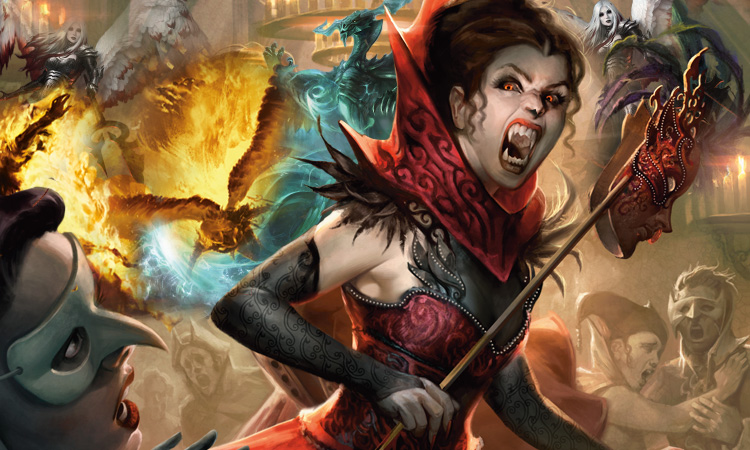Abandon Ship!
You're drafting Black-Red Vampires. You're firmly in the deck with a pile of black and red cards so far.
But then you take a look at your next pack. One of the strongest Limited cards in the entire set, Archangel Avacyn, is staring back at you. What should you do?
You're suddenly a game show contestant, wondering what's behind door number two.
You're suddenly the Doctor, faced with the choice of saving only one of two planets.
You're suddenly Sarkhan, on the precipice of deciding to save Ugin.
You're suddenly...a drafter, with a hard decision to make.
You've created a fork in time itself.

But it's okay. Breathe. There are ways to figure this out. We can make this work without creating a temporal paradox.
With me? Yes? No? Good. Let's carry on.
Booster Draft is like life: it's a sequence of decisions that impacts the future decisions of yourself and everybody around, and will determine your future—for better or worse.
You're going to run into these kinds of draft-defining decisions a lot. How do you know when to abandon ship or stay the course?
One of the fun and exciting things about drafts is that no two are the same. But this can complicate things, because you always have to be making decisions that are specific to that exact draft. What was the right decision yesterday might entirely blow up in your face today.
Fortunately, while there is no absolute, 100% guaranteed cheat sheet for what to do in any given draft, there are some general questions you can ask yourself that should give you a better idea of what to do and how to set yourself up for success.
What might they be? Well, I'm glad you asked...
What Would You Be Giving Up?
When it comes to abandoning one color for another, it's important to ask: What would you be giving up?
Let's say you've started off your draft. You first-picked a Fiery Temper and second-picked an Heir of Falkenrath. And then third pick you see that Avacyn.
If you ask yourself this question, you can probably come to the quick conclusion that you should slam that Avacyn.
You're only two cards into your draft, you haven't committed to either color, and I'd rather have Avacyn than either of those cards. There's no guarantee that either red or black is even going to work out.
Now let's look at it from the other angle. You're firmly in black-red with a good-looking, nearly complete deck and you get passed Avacyn in your third pack of the draft.
While Archangel Avacyn is a strong card, and it's a bit painful to pass, there's basically no way you're going to play it here. You aren't going to find a bunch of white cards that surpass your current deck in the middle of the third pack.
Now let's change the situation a bit. Instead of Avacyn, it's a Nearheath Chaplain.
In the second third-pack situation, it's pretty clear you just let the Chaplain pass on by. But let's go back to the first situation.
You have that Fiery Temper and Heir of Falkenrath. You see the Chaplain. Now, you could pick it and split your cards among the three colors and just figure it out later. But in that pack is also a Mad Prophet.
The Chaplain is probably overall the slightly stronger card. But if you take the Chaplain, I'd say you are very unlikely to play all three of those cards in your final deck. One of them is going to be a "wasted" pick. If you take the Prophet, it means you can play with both that Fiery Temper and the Prophet in your final deck—and it helps make sure that Temper makes the cut.
You can expand this to cover situations further down the pipeline. In general, the more cards you have to give up for a single card, the stronger that card needs to be to consider it.
But there's far more to it that just that. And what about, going back to the original example, if the time you open Avacyn is at the beginning of your second pack?
This is where things start to get murkier and it becomes very draft-dependent. So let's look at another heuristic...
Signals and Opportunity Cost
Okay, so those might not be the most exciting words in the world—but they're both very important when figuring out which direction you should go in.
Let's look first at signals.
In a Magic draft, the act of signaling doesn't mean winks, nods, and tapping Morse code on the table, it means looking at what colors you're passing and being passed. Often, looking at what you're passing and what you're being passed can be just as crucial to your draft success as taking a card!
Let's talk about how this plays out practically. If you take all red cards in the first pack, it means the people to your left aren't getting passed many red cards—which means in pack two, when they're the ones passing to you, then you should get hooked up with some pretty sweet red goodies.
Similarly, if you're in the first pack and four picks in you get a pack with two first-pickable black cards, that's a good indicator that more black cards will keep coming.
How does this apply to knowing if you should abandon ship and switch in the middle of the draft?
Well, let's go back to the trickier version of our example now. You started off in Black-Red Vampires throughout the first pack. You open Avacyn in pack two. Should you take her?
This is where signals really start to come into play.
Let's say that you remember, as you were passing cards, that you passed many strong white cards as you were taking your red and black cards. That means the people to your left are likely to have taken them. If you take this Avacyn, you're actually pretty unlikely to see many good white cards to help you move into that color this pack—which means the pick probably isn't worth it.
On the flip side (pun with Avacyn only slightly intended), if you didn't see much white coming from your right, then you have a pretty interesting choice.
The people to your left probably aren't strongly in white because you didn't pass that much of it. If you take this Avacyn, you'll probably get a bevy of strong white cards this pack.
All good, right? Well, that doesn't come without a cost: if you didn't see many white cards, then somebody to your right is probably in white!
Essentially, taking the Avacyn in this situation rewards you this pack with white cards, but means you won't see many white cards in pack three. So a lot depends on how strong the cards in your deck already are: if you have really strong black and red cards, it may be better to stay the course, but if one color is just okay, it might be better to plan on abandoning one and reaping the white rewards from this pack.
Of course, it's not like taking that Avacyn locks you into playing white. And that's where opportunity cost comes in.
What is the opportunity cost of taking Avacyn here?
Opportunity cost, a term borrowed from economics, is defined by the Oxford English Dictionary as "the loss of potential gain from other alternatives when one alternative is chosen."
Or, in the context I'm going for here, more simply the question of: "What are you giving up by making this choice?"

The opportunity cost of taking the Avacyn here essentially means that you aren't taking another card instead.
Let's say, theoretically, that there was no other card in this pack that you would play in your black-red deck anyway. Well, in that case you should probably take the Avacyn and see if you do indeed get passed great white cards. If it doesn't work out, no big deal, and if it does work out, you now have Archangel Avacyn on your team!
On the other hand, if the pack has a very strong card for Black-Red Vampires/Madness—let's say Incorrigible Youths—then you're definitely missing out on something for your current deck. If taking the Avacyn doesn't work out, you just missed the opportunity to pick a top card for your archetype. Incorrigible Youths is likely one of the strongest cards in your archetype, and in this situation I think I'd take the Youths.
So, to recap: First, I'd look at what the signals say and have said. Then, with that context in mind, I'd figure out what the opportunity cost of taking this card is.
Though the alternative can be tempting, often it's right to stay the course if there is a high opportunity cost.
Are You What You Think You Are?
And I'm not just asking this question because we're on Innistrad
Finally, a very important thing to do is constantly evaluate what you've done and make sure that what you have in your head is actually what's reflected in your draft.
Let's say you start by taking a bunch of aggressive cards. You get in your head that you're drafting an aggressive deck. Then some removal floats your way and you take that. You round the pack out with some better defensive creatures. Then, in pack two, you have the choice between an aggressive early creature like Howlpack Wolf or a slower card that can dominate the late game like Morkrut Necropod.
Human nature is to take the first thing we think of and believe, and then cement that in stone. But if your mindset is still in aggressive mode, you may accidentally fail to realize that your deck is actually not set up to be aggressive at all! You want the slower card.
This is similarly true with colors. I can't tell you the number of drafts I've done where I thought I was definitely two colors—say red and black—but then I get to the end of the draft and realize I only have six black cards I'm excited about playing because I got mentally locked in on it early!
The takeaway here is to always try and make sure you actually have the kind of deck you think you have. There's no reason to pass up on that Avacyn here if your black consists of just one okay card.
Ship Shape
Drafting is so easy to do—yet extraordinarily difficult to master.
To know when to switch and truly abandon ship, you ideally want to have everything you've done in your head, from signals to what you've taken so far—which can be a challenge. But the next time you have this kind of situation come up, think back on the draft. Think about your deck. Ask yourself some of these questions. I think you'll find it at least a little bit easier—and it'll give you a great path to become even better at it in time!
If you have any thoughts about switching during a draft, or any examples where you're wondering if you should switch or not, I'd love to hear from you. I may even use your situation in a future article!
Feel free to contact me on Twitter or Tumblr, and you can also reach me through e-mail at beyondbasicsmagic@gmail.com.
Until next time, may you abandon ship at all the right times.
Talk with you again next week,
Gavin

